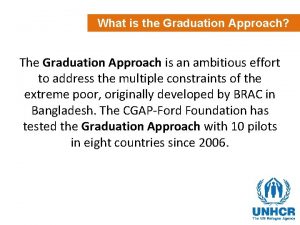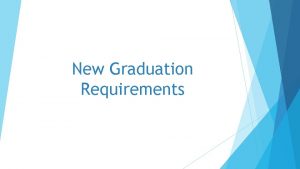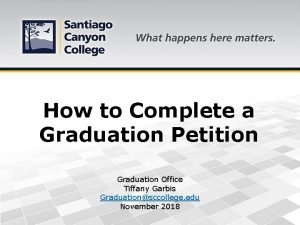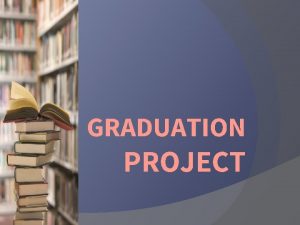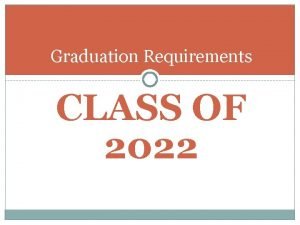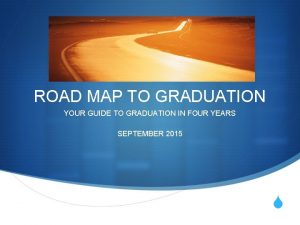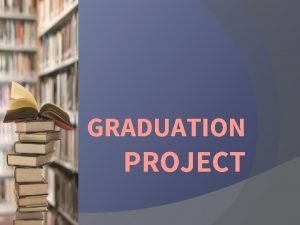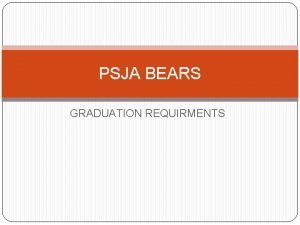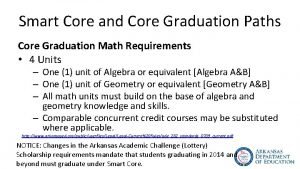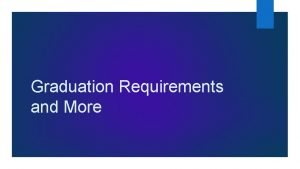What is the Graduation Approach The Graduation Approach



































- Slides: 35

What is the Graduation Approach? The Graduation Approach is an ambitious effort to address the multiple constraints of the extreme poor, originally developed by BRAC in Bangladesh. The CGAP-Ford Foundation has tested the Graduation Approach with 10 pilots in eight countries since 2006.

Creating Pathways for the Poorest Sequencing Interventions: To help very poor people move out of poverty promotion transformation creating ladders safety nets + livelihoods + microfinance protection prevention stabilization sequencing 2

The Graduation Approach

CGAP-Ford Foundation Pilot Sites Research Sites Graduation

Graduation Approach Evaluation Results o Impacts of 8/10 indicators still evident 12 months after the intervention o Income significantly higher in all countries – in the majority of these countries exceeding the cost of the program o Household consumption significantly higher in all countries but Honduras o Lessons for future implementations – the context and the quality of implementation are important Abhijit Banerjee et al. Science 2015; 348: 1260799 “The Graduation approach has led to broad improvements in key dimensions of economic and non-economic well-being…Policymakers seeking a program to sustainably improve the lives of the very poor should consider investing in this approach. ” Esther Duflo, J-PAL

Questions?

GRADUATION APPROACH COMPONENTS GRADUATION CRITERIA

GRADUATION CRITERIA A rigorous criteria to define program success and to establish interim and end goals for program participants. Graduation Criteria Provide a Means to: o Define what is ‘Graduation’ in the context of the target population o Determine the length of the program (time to achieve Graduation) o Rationalize the design of the program o Provide concrete goals and objectives for staff and participants o Select key indicators to track performance

GRADUATION CRITERIA Sample Graduation Category Food security Income, Assets and savings Self-confidence /agency o o o Health Other o o o Criteria Participant’s family is food secure (“household eats a cooked meal at least once a day” or “household is eating at least two meals a day per day all year round” or “ household does note experience starvation due to unavailability of food” Household has at least two sources of income and owns income-generating assets/and or savings worth at least US$ XXX Participants have a plan for the future and/or “feel they have made progress through the course of the program. ” Other examples: Participant is able to write her name. Participants are aware of accessible government programs. Households know and demand their rights and are aware of where to report instances of abuse. Participant maintains basic hygiene and has access to healthcare Participants’ hemoglobin level must reach a “normal” level Participants maintains basic hygiene Household has access to healthcare All children aged five to ten are attending school if a school is accessible in a radius of 1. 5 km

Reaching graduation o Coaching visits help measure a participant’s progress in achieving their individual Graduation goals and address problems if they appear unable to meet them. o It is best to wait until the end of the program cycle and then celebrate graduation collectively for all participants in a cohort. o Typically a Graduation ceremony is held for participants, their families, and their coaches to celebrate their success, talk about lessons learned, and discuss next steps. o If there are participants who are not able to meet program goals, managers must determine ahead of time what actions to take. At Graduation it is important to remind participants about what, if any, support they can continue to expect and reiterate where they can access other programs and services.

GRADUATION CRITERIA examples Trickle Up (India): Selects Graduation criteria jointly with participants a the beginning of the program. In one case, participants who had not reached all of the criteria felt they had nonetheless successfully emerged from extreme poverty and would remain that way. They were allowed to graduate and the criteria used were re-assessed for subsequent cycles. UNHCR (Costa Rica): Give piggy banks to their participants at the start of the program to encourage them to save. One of their Graduation criteria is the use of these piggy banks to help reinforce the message. UNHCR (Egypt): Had still not decided on Graduation criteria after 2 years of operating the program. This led to considerable confusion and lack of direction on the part of staff and participants.

GRADUATION APPROACH TARGETING Targeting, or participant selection, consists of these elements in a rural context: o Area selection GRADUATION CRITERIA o Community selection o Community mapping A rigorous procedure to ensure the most vulnerable in a community benefit from the program. o Wealth ranking o Verification For transparency, accuracy, and to build buy-in/trust, community participation is essential!

GRADUATION APPROACH LIVELIHOODS Things to consider: GRADUATION CRITERIA Livelihoods encompass the market assessment, skills training, and asset transfer (cash or in-kind) Innovations/adaptations include using faster-learning participants as mentors and facilitating safe wage employment o Livelihoods must fit into the value chain o Know your market o Know your participants’ challenges and opportunities o Mix short and long-term activities - diversify to mitigate risks o Support services are key – ensure you have the right technical skills available o Appropriate training & coaching are keys to ensuring success Barefoot Vet

MARKET ASSESSMENT Conducted to choose appropriate livelihood options and give information on issues such as food security and access to financial services. o What to consider: market overview, priority sectors, value chain analysis, cashflow, opportunities for sustainability & scale o Markets are dynamic: Be aware of ongoing market conditions to monitor changes that will economically affect participants o Markets vary from region to region: Do not assume opportunities in one area will be suitable in another. Depending on the context (e. g. rural/urban), opportunities may exist for self-employment enterprises and/or wage employment. o Selection of activities is important: Provide a wide enough selection to accommodate participant skills and avoid flooding the market without burdening the program with too much complexity.

MARKET ASSESSMENT Ranking Matrix This is an example of a viable market ranking matrix used by REST in Ethiopia:

Wage employment o Particularly in an urban environment, wage employment opportunities may be the best solution for participants given that: o They are provided with the proper skills and training o They are not put at risk or taken advantage of by employers or employment conditions o Relations with employers are maintained and monitored by program staff Important questions for potential employers: o Identification/documentation requirements o Training/skills requirements o Conditions of employment: compensation, benefits, transportation, hours, options for promotion/growth, training offered, etc. o Potential issues for vulnerable employees (gender, disability, status) and strategy for addressing these o Problem identification and resolution process

Livelihood examples Trickle Up (India): Promoted an improved method of cultivating rice (system of rice intensification). Participants were initially adverse to change, but a few decided to try it on a limited basis. The results were so successful, the early adopters became leaders for the whole community in disseminating the new approach. UNHCR (Egypt): Found that wage employment opportunities were not suitable for female participants as travel outside the home put their security at risk and left children unattended. UNHCR negotiated with international companies such as Unilever to create in-home sales opportunities. UNHCR (Ecuador): Has negotiated agreements with a number of private sector companies and helped create linkages with CERES (an international certification institution for socially responsible companies) and the Ministry of Labor. They hold regular events to recognize existing employers and recruit new ones. In designing their training courses, employers are first asked to list their skills requirements.

GRADUATION APPROACH COACHING Coaching Provides: o A regular touch-point to track participant GRADUATION CRITERIA progress and identify issues o A means to reinforce skills training o Encouragement for positive attitudinal Ongoing engagement with changes (e. g. , health, education) participants is crucial to helping o Linkages with social programs participants gain the skills and o Support in developing self-confidence to develop and o Information for M&E follow a personalized pathway from extreme poverty to selfsufficiency. Where weekly coaching is not possible, alternatives exist such as: community coaches, peer-to-peer support groups, and technologies (cell phones, tablets, etc. )

Coaching What to Decide in Designing the Coaching Component o Assessment of budget and resource needs o Coaching duration and frequency o Method of coaching o Linkages available to support coaching o Coaching content o Profile and skills required for coaches o Training requirements for coaches o Coaching resources and materials o Tailored versus uniform coaching o Systems/processes/tools for monitoring coaching Coaches do not need to have the answers to all questions, but should know where to find them. Coaches should meet weekly amongst themselves to resolve any questions and share information.

Qualities of a good coach o Respect for participants and desire to engage with them as equals. o Ability to listen to before proposing solutions, and to work with participants to creatively resolve issues together. o Open and encouraging attitude. o Ability to seek answers and identify resource persons when necessary. o Willingness to adapt the support that is given to the needs of the household Appropriate staff selection, orientation, and ongoing training is essential to ensuring success. The same coach should accompany a participant throughout the program to establish trust and ensure good monitoring.

Coaching examples Fundación Capital (Mexico, Colombia, Paraguay): Works with governments in implementing the Graduation approach. They have integrated technologies such as cellphones and tablets with training modules for participants to attempt to address the challenges of providing coaching at scale. Trickle Up (India): Uses savings and credit groups to provide peer-to-peer coaching and training to support the work of their field officers. UNHCR (Egypt, Costa Rica, Ecuador, Burkina Faso): Trains extension workers who are already skilled in either psychosocial support or in livelihood development to provide all aspects of coaching so that participants have a consistent point of contact.

GRADUATION APPROACH FINANCIAL SERVICES Purpose of savings and financial education: o Safe place for vulnerable to save o Instill good financial habits GRADUATION CRITERIA o Promote mindset of planning for the future Graduation and should be MFIs BANK/ POST OFFICE introduced early in the program. Participants do not need to save much to begin – it is the habit that is important. Therefore, consumption support and savings can occur at the same time. VSLA/ SHG are a critical factor for success in o Savings groups: Promote solidarity VILLAGE BANK Savings and financial education o Help build assets and safety net

FINANCIAL SERVICES Planning a Savings Strategy Ø Calculate the optimal amount of savings to buffer participants without encouraging hardship. o What is the amount of savings needed to sustain a family for 3 months if there is a shock? o How much can a participant save during the program to achieve this? o When will income from livelihoods be available to help (short, medium & longterm)? o What is the most sustainable option for guarding these savings? o What financial training is required for participants?

SAVINGS GROUPS Ø Called savings groups, village savings and loan associations (VSLAs), or self-help groups (SHGs) Ø Associations of 10 -25 members that provide financial services as well as a support network that will last beyond the length of the program. o Vehicle for financial services. o Organized group coaching and training. o Offer platform for accessing banks/public services, defending rights, and spearheading change. o Possibility for connection to other networks. o Promote self-respect, self determination, economic independence, protection for women, and social transformation.

SAVINGS GROUPS Best Practices Ø Build affinity: o Develop good conflict resolution strategies o Ensure that members feel equal to one another - determine if mixing different ethnic, social, or religious groups is desirable or not Ø Diversify livelihood activities within the group to manage risks Ø Build financial and social discipline: o Establish and follow rules of procedure, including participation o Where possible, rotate leadership and other roles and work to gain independence from coaches o Balance focus on economics as well social elements o Provide financial training (there are many possible solutions to literacy & numeracy issues) Ø Work with existing structures rather than attempt to replace them

FINANCIAL SERVICES examples SKS (India): Supports in-kind savings that are contributed towards a communal food bank. Trickle Up (India): Helped their participants negotiate with local banks and was successful in bringing bank officers to the villages where they worked for registration days. Problems of insufficient identification were solved by issuing TU identification cards to be used in conjunction with national ID. Self-help groups formed through the Graduation program are now being linked into a regional, Government-supported network. Trickle Up (Guatemala): Learned that integrating people with disabilities into existing savings groups can help establish important links with members of the community, however coaches play an important role in facilitating this integration and breaking down barriers of stigma and discrimination.

GRADUATION APPROACH CONSUMPTION Things to consider when deciding on consumption support: o Participant needs o Duration o Timing Consumption stipends are an o Form optional component, used to o Individualized vs uniform support participants who are at o Linkages to existing social protection programs risk of selling assets or not being MARKET GARDEN NON-FOOD ITEMS VOUCHER CASH able to participate.

Consumption stipend o Buffer for families while participating and before economic activities start generating profits. o Are there weeks or months in the year when one or more family members cannot eat more than two meals a day? When? For how long? o Did your family migrate away from home in the past 3 years? How many times? For how long? o Did you or any family members engage in any unsafe work activities in the past 3 years to earn money for consumption? o Encouragement to stay and participate in the program for families that practice distress migration or other unsafe economic activities. o Bridge during the lean season when participants risk being forced to sell off assets. o Support to women who cannot work in the last months of pregnancy or just after childbirth. o Should be closely monitored in the pilot phase to determine if it is necessary and if the amount and the duration are sufficient.

Consumption stipend examples Bandhan (West Bengal, India): Duration of consumption support is linked to livelihoods – for example participants engaged in agriculture receive support for longer periods to account for delays in generating income as compared to those starting small enterprises such as shops. Trickle Up (India): Participants only receive support in the lean season when caloric intake is insufficient and daily wage labor is not readily available to bring money into the household. Linkages are made to Government social support programs and kitchen gardens are promoted to improve nutritional quality. Fonkoze (Haiti): Uses regular payment of consumption support at the beginning of the program to build trust with participants and encourage planning ahead. REST (Ethiopia): Tied their consumption support to public works payment-for-labor programs.

Questions?

• Hyperlinks

Program Evaluation Results Abhijit Banerjee et al. Science 2015; 348: 1260799 Back

Bangladesh: Social Protection Framework Back 33

Graduation Approach and Scale Organization Pilot Country Pilot Participant # Scale Up # Years elapsed Bandhan India 300 17, 249 6 Large grant (Axis Bank), funding with profits from MFI Trickle Up India 300 8, 470 6 Increasing # of participants/partner and increasing # of partners PPAF Pakistan 1, 000 43, 100 6 Graduation components integrated into national livelihood promotion unit Strategy Back

Developing an Analytical Framework for Action: Challenging Extreme Poverty 35 BACK
 Graduation approach
Graduation approach Sơ đồ cơ thể người
Sơ đồ cơ thể người Công của trọng lực
Công của trọng lực Các số nguyên tố
Các số nguyên tố đặc điểm cơ thể của người tối cổ
đặc điểm cơ thể của người tối cổ Tỉ lệ cơ thể trẻ em
Tỉ lệ cơ thể trẻ em Các châu lục và đại dương trên thế giới
Các châu lục và đại dương trên thế giới ưu thế lai là gì
ưu thế lai là gì Thẻ vin
Thẻ vin Môn thể thao bắt đầu bằng chữ f
Môn thể thao bắt đầu bằng chữ f Tư thế ngồi viết
Tư thế ngồi viết Cái miệng xinh xinh thế chỉ nói điều hay thôi
Cái miệng xinh xinh thế chỉ nói điều hay thôi Hình ảnh bộ gõ cơ thể búng tay
Hình ảnh bộ gõ cơ thể búng tay Từ ngữ thể hiện lòng nhân hậu
Từ ngữ thể hiện lòng nhân hậu Trời xanh đây là của chúng ta thể thơ
Trời xanh đây là của chúng ta thể thơ Tư thế ngồi viết
Tư thế ngồi viết Thứ tự các dấu thăng giáng ở hóa biểu
Thứ tự các dấu thăng giáng ở hóa biểu Voi kéo gỗ như thế nào
Voi kéo gỗ như thế nào Thơ thất ngôn tứ tuyệt đường luật
Thơ thất ngôn tứ tuyệt đường luật Sự nuôi và dạy con của hươu
Sự nuôi và dạy con của hươu Diễn thế sinh thái là
Diễn thế sinh thái là đại từ thay thế
đại từ thay thế Thế nào là hệ số cao nhất
Thế nào là hệ số cao nhất Frameset trong html5
Frameset trong html5 Vẽ hình chiếu vuông góc của vật thể sau
Vẽ hình chiếu vuông góc của vật thể sau Thế nào là mạng điện lắp đặt kiểu nổi
Thế nào là mạng điện lắp đặt kiểu nổi Cách giải mật thư tọa độ
Cách giải mật thư tọa độ Lời thề hippocrates
Lời thề hippocrates Vẽ hình chiếu đứng bằng cạnh của vật thể
Vẽ hình chiếu đứng bằng cạnh của vật thể Chụp tư thế worms-breton
Chụp tư thế worms-breton Quá trình desamine hóa có thể tạo ra
Quá trình desamine hóa có thể tạo ra Khi nào hổ mẹ dạy hổ con săn mồi
Khi nào hổ mẹ dạy hổ con săn mồi Các châu lục và đại dương trên thế giới
Các châu lục và đại dương trên thế giới Dạng đột biến một nhiễm là
Dạng đột biến một nhiễm là điện thế nghỉ
điện thế nghỉ Bổ thể
Bổ thể
